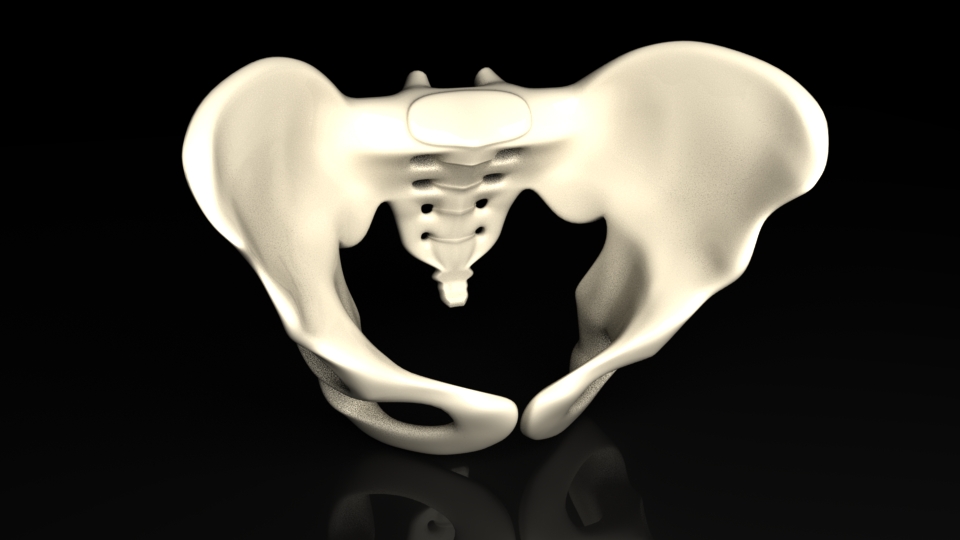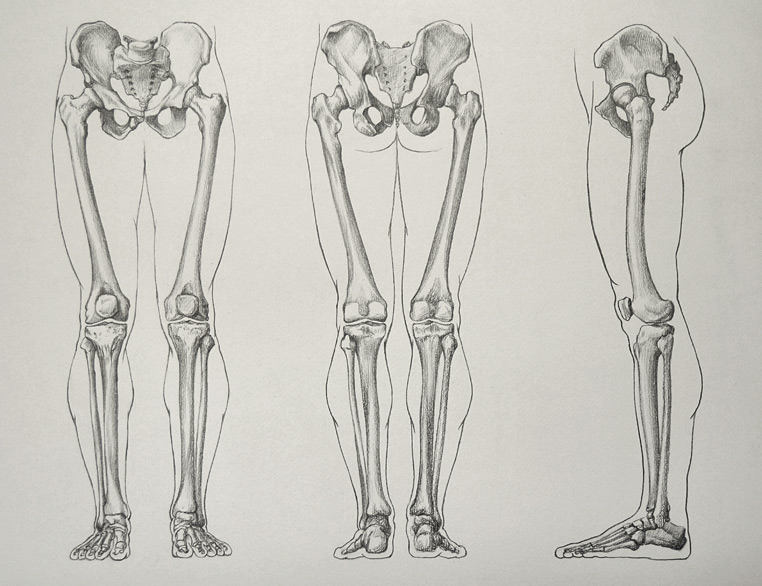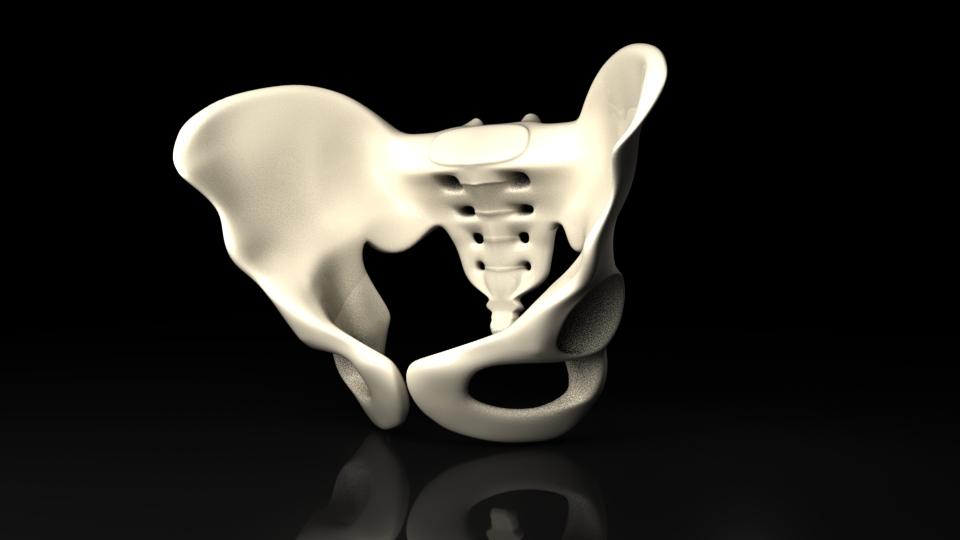Pelvis Project
Product Visualization

Das Becken Projekt war eins der aller ersten organischen Projekte und seither fester Bestandteil des Modell-Archivs. Als Teil des Skelett Modells eines Menschen und durch seine einzigartige Form eignet es sich perfekt als Beispiel für eine Inszenierung des Umwandelns einer 2D Vorlage zum 3D Modell.
Wie man im oberen Bild sehen kann, wird als erstes eine Kollage verschiedener Quellen zusammengesetzt um ein Vorlage für die ungefähren Proportionen bekommt.
Dazu werden immer eine Seitenansicht und eine Frontansicht verwendet um immer dreidimensional zu konstruieren. Hier sieht man eine transparente Ansicht des Modells in der Maya Software. Bestehend aus Ecken,Kanten und Flächen, bilden mehrere Quadrate am Ende das virtuelle Modell. Durch verändern der jeweiligen Koordinaten dieser Ecken, Kanten und Flächen verändert sich logischer Weise die Form. Im Verhältniss zu der umliegenden Flächen bilden sich dann eben Schrägen oder Graden. Tiefe und Dreidimensionalität entsteht.
Die Oberfläche wird mit einer Textur oder einem Shading versehen welches dann sowohl die Haptik und Farbe des Objekts bestimmt, als auch die Schraffur oder Abnutzung etc.
Das Becken Projekt war eins der aller ersten organischen Projekte und seither fester Bestandteil des Modell-Archivs.
Als Teil des Skelett Modells eines Menschen und durch seine einzigartige Form eignet es sich perfekt als Beispiel für eine Inszenierung des Umwandelns einer 2D Vorlage zum 3D Modell. Wie man im oberen Bild sehen kann, wird als erstes eine Kollage verschiedener Quellen zusammengesetzt um ein Vorlage für die ungefähren Proportionen bekommt.
Dazu werden immer eine Seitenansicht und eine Frontansicht verwendet um immer dreidimensional zu konstruieren.
Das Becken Projekt war eins der aller ersten organischen Projekte und seither fester Bestandteil des Modell-Archivs. Als Teil des Skelett Modells eines Menschen und durch
seine einzigartige Form eignet es sich perfekt
als Beispiel für eine Inszenierung des Umwandelns einer 2D Vorlage zum 3D Modell.
Wie man im oberen Bild sehen kann,
wird als erstes eine Kollage verschiedener Quellen zusammengesetzt um ein Vorlage für
die ungefähren Proportionen bekommt.
Dazu werden immer eine Seitenansicht und
eine Frontansicht verwendet um immer dreidimensional zu konstruieren.
Das Becken Projekt war eins der aller ersten organischen Projekte und seither fester Bestandteil des Modell-Archivs. Als Teil des Skelett Modells eines Menschen und durch seine einzigartige Form eignet es sich perfekt als Beispiel für eine Inszenierung des Umwandelns einer 2D Vorlage zum 3D Modell. Wie man im oberen Bild sehen kann, wird als erstes eine Kollage verschiedener Quellen zusammengesetzt um ein Vorlage für die ungefähren Proportionen bekommt. Dazu werden immer eine Seitenansicht und eine Frontansicht verwendet um immer dreidimensional zu konstruieren. Hier sieht man eine transparente Ansicht des Modells in der Maya Software. Bestehend aus Ecken,Kanten und Flächen, bilden mehrere Quadrate am Ende das virtuelle Modell. Durch verändern der jeweiligen Koordinaten dieser Ecken, Kanten und Flächen verändert sich logischer Weise die Form. Im Verhältniss zu der umliegenden Flächen bilden sich dann eben Schrägen oder Graden.
Tiefe und Dreidimensionalität entsteht. Die Oberfläche wird mit einer Textur oder einem Shading versehen welches dann sowohl die Haptik und Farbe des Objekts bestimmt, als auch die Schraffur oder Abnutzung etc.
Das Becken Projekt war eins der aller ersten organischen Projekte und seither fester Bestandteil des Modell-Archivs.
Als Teil des Skelett Modells eines Menschen und durch seine einzigartige Form eignet es sich perfekt als Beispiel
für eine Inszenierung des Umwandelns
einer 2D Vorlage zum 3D Modell. Wie man im oberen Bild sehen kann, wird als erstes eine Kollage verschiedener Quellen zusammengesetzt um ein Vorlage für die ungefähren Proportionen bekommt.
Dazu werden immer eine Seitenansicht und eine Frontansicht verwendet um immer dreidimensional zu konstruieren.

Haben sie weiter Fragen zu diesem Projekt oder der Erzeugung von organischen Modellen? Haben sie ein Konzept eines solchen Modell, das produziert werden soll?
Haben sie weiter Fragen zu diesem Projekt oder der Erzeugung von organischen Modellen? Haben sie ein Konzept eines solchen Modell, das produziert werden soll?
Haben sie weiter Fragen zu diesem Projekt oder der Erzeugung von organischen Modellen? Haben sie ein Konzept eines solchen Modell, das produziert werden soll?
Haben sie weiter Fragen zu diesem Projekt oder der Erzeugung von organischen Modellen? Haben sie ein Konzept eines solchen Modell, das produziert werden soll?

The pelvis project was one of the very first organic projects and since a steady feature of the model archive. As part of the human's skeletton model and also because of its unique shape is perfectly suited for being an example of the staging of the convertation from a 2D template to the actual 3D model. As you can see in the top picture, the first step is to create a collage out of different sources to get a template of rough proportions. That always needs a side- and frontview to constantly construct threedimensional.
Here you see a transparent view of a model in the Maya software. Many squares consisting of Edges, Vertecies and faces form the final virtual model. By changing the respective coordinates of these edges, vertecies and faces you also logicly change the shape. In relation to the surrounding faces slants and straights are created. Depth and threedimensonality emerges.
Textures or shadings will be assigned to the surface, which then determines the haptic and the color of an object as well as the attrition or the hatching etc.
The pelvis project was one of the very first organic projects and since a steady feature of the model archive.
As part of the human's skeletton model and also because of its unique shape is perfectly suited for being an example of the staging of the convertation from a 2D template to the actual 3D model. As you can see in the top picture, the first step is to create a collage out of different sources to get a template of rough proportions. That always needs a side- and frontview to constantly construct threedimensional.
The pelvis project was one of the very
first organic projects and since a steady feature of the model archive. As part of the human's skeletton model and also because of its unique shape is perfectly suited for being an example
of the staging of the convertation from a 2D template to the actual 3D model. As you can see in the top picture, the first step is to create a collage out of different sources to get a template of rough proportions. That always needs a
side- and frontview to constantly construct threedimensional
The pelvis project was one of the very first organic projects and since a steady feature of the model archive. As part of the human's skeletton model and also because of its unique shape is perfectly suited for being an example of the staging of the convertation from a 2D template to the actual 3D model. As you can see in the top picture, the first step is to create a collage out of different sources to get a template of rough proportions. That always needs a side- and frontview to constantly construct threedimensional. Here you see a transparent view of a model in the Maya software. Many squares consisting of Edges, Vertecies and faces form the final virtual model. By changing the respective coordinates of these edges, vertecies and faces you also logicly change the shape. In relation to the surrounding faces slants and straights are created. Depth and threedimensonality emerges. Textures or shadings will be assigned to the surface, which then determines the haptic and the color of an object as well as the attrition or the hatching etc.
The pelvis project was one of the very first organic projects and since a steady feature of the model archive. As part of the human's skeletton model and also because of its unique shape is perfectly suited for being an example of the staging of the convertation from a 2D template to the actual 3D model. As you can see in the top picture, the first step is to create a collage out of different sources to get a template of rough proportions.
That always needs a side- and frontview to constantly construct threedimensional.

Do you have any further Questions concerning this project or the creation of organic models? Do you have a concept of such a model which shall be produced?

